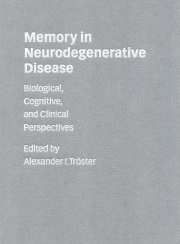Book contents
- Frontmatter
- Contents
- List of contributors
- Preface
- PART I Biological perspectives
- 1 Nonhuman primate models of memory dysfunction in neurodegenerative disease: contributions from comparative neuropsychology
- 2 Nonprimate animal models of motor and cognitive dysfunction associated with Huntington's disease
- 3 Neuropathology and memory dysfunction in neurodegenerative disease
- 4 Neurochemical aspects of memory dysfunction in neurodegenerative disease
- 5 Structural neuroimaging correlates of memory dysfunction in neurodegenerative disease
- 6 Functional neuroimaging correlates of memory dysfunction in neurodegenerative disease
- 7 The biology of neurodegenerative disease
- PART II Cognitive perspectives
- PART III Clinical perspectives
- Index
7 - The biology of neurodegenerative disease
from PART I - Biological perspectives
Published online by Cambridge University Press: 23 November 2009
- Frontmatter
- Contents
- List of contributors
- Preface
- PART I Biological perspectives
- 1 Nonhuman primate models of memory dysfunction in neurodegenerative disease: contributions from comparative neuropsychology
- 2 Nonprimate animal models of motor and cognitive dysfunction associated with Huntington's disease
- 3 Neuropathology and memory dysfunction in neurodegenerative disease
- 4 Neurochemical aspects of memory dysfunction in neurodegenerative disease
- 5 Structural neuroimaging correlates of memory dysfunction in neurodegenerative disease
- 6 Functional neuroimaging correlates of memory dysfunction in neurodegenerative disease
- 7 The biology of neurodegenerative disease
- PART II Cognitive perspectives
- PART III Clinical perspectives
- Index
Summary
INTRODUCTION
The ‘Biological Perspectives’ represented in the first part of this book point to the tremendous advances made in the understanding of neurodegenerative conditions since their early descriptions. Many of these advances would not have been possible without animal research and several chapters highlight the importance of studying the behavior of animals with surgical or ‘chemical’ brain lesions in order to gain insights into basic mechanisms of neurodegenerative diseases. The chapters also discuss methodological approaches, such as neurochemical and neuroanatomical ones, to elucidate structure–function relations in patients with neurodegenerative diseases. In the sections that follow, the utility of animal models of neurodegenerative diseases is discussed. This is followed by an analysis of studies with humans examining the neurochemical and neuroanatomical correlates of memory in neurodegenerative diseases.
ANIMALS AS MODELS OF NEURODEGENERATIVE DISEASES IN HUMANS
While specific etiologies have been discovered for some neurodegenerative diseases, the causes of others remain the object of scientific curiosity and fascination. Oscar-Berman and Bardenhagen (Chapter 1) dealt with one approach to unravel some of the many questions accompanying neurodegenerative diseases, namely the conduct of animal research – especially with regard to memory disturbances. These authors strongly argue for the feasibility of extrapolating from animal data to human conditions and provide numerous examples of both animal studies with implications for human behavior and of ‘animal’ tasks used in studies of patients with neurodegenerative diseases. Nevertheless, the authors acknowledge that the sensitivity of ‘animal’ tests to human memory dysfunction has still to be determined and that methodological limitations, including an improper mimicking of human neurodegenerative diseases in animal models, may hinder proper inferences and outcomes.
- Type
- Chapter
- Information
- Memory in Neurodegenerative DiseaseBiological, Cognitive, and Clinical Perspectives, pp. 140 - 154Publisher: Cambridge University PressPrint publication year: 1998



